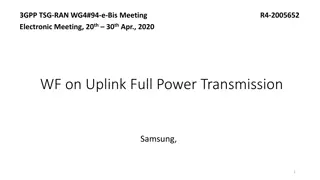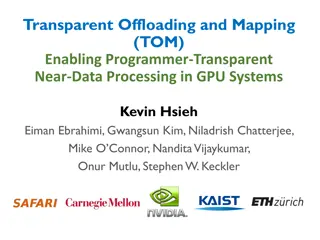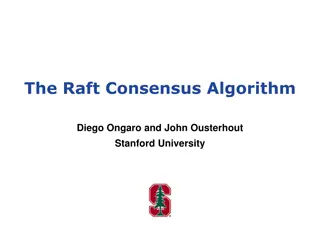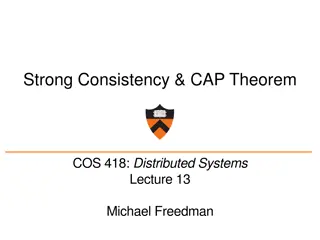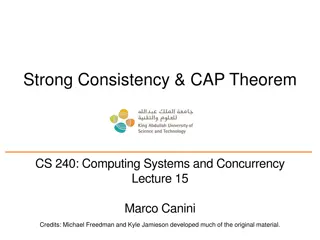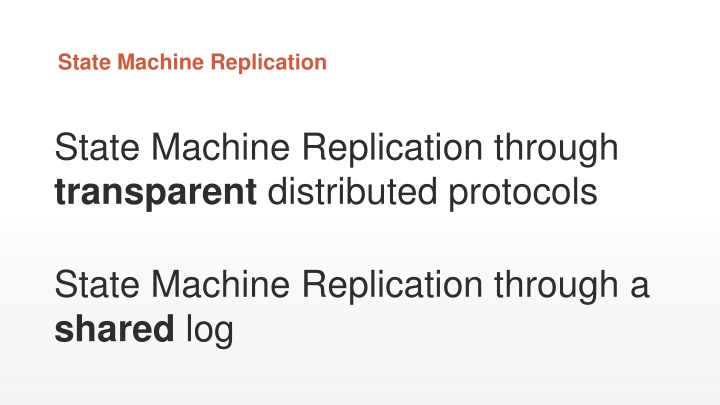
Transparent State Machine Replication via Distributed Protocols
Explore the concept of State Machine Replication (SMR) through transparent distributed protocols and a shared log. Discover the challenges faced with traditional SMR systems and the innovative solutions like CRANE that aim to overcome these obstacles and ensure reliable replication without program modification.
Download Presentation

Please find below an Image/Link to download the presentation.
The content on the website is provided AS IS for your information and personal use only. It may not be sold, licensed, or shared on other websites without obtaining consent from the author. If you encounter any issues during the download, it is possible that the publisher has removed the file from their server.
You are allowed to download the files provided on this website for personal or commercial use, subject to the condition that they are used lawfully. All files are the property of their respective owners.
The content on the website is provided AS IS for your information and personal use only. It may not be sold, licensed, or shared on other websites without obtaining consent from the author.
E N D
Presentation Transcript
State Machine Replication State Machine Replication through transparent distributed protocols State Machine Replication through a shared log
Paxos Made Transparent Heming Cui, Rui Gu, Cheng Liu, Tianyu Chenx, and Junfeng Yang Presented by Hassan Shahid Khan
Server Motivation High availability Fault-resistance Network Client Client Client
Replica Replica State Machine Replication (SMR) Model program as state machine - States program data - Transitions deterministic executions of the program under input requests Network Ensure correct replicas step through the same sequence of state transitions Need distributed consensus (PAXOS?) to ensure same sequence of input requests to all replicas Client Client Client
Some problems with SMR systems 1. Cannot handle multi-threaded programs (which most server programs are!) - Sources of non-determinism: thread interleaving, scheduling, environment variables etc. 2. Narrowly defined consensus interfaces and require program modification. - Often tailor-made to fit requirements e.g Chubby a locking service.
Solution: CRANE (Correctly ReplicAting Nondeterministic Executions) A transparent SMR system. Focus on functionality (not replication) run any program on top of CRANE without any modification.
Contributions 1. Chooses a socket-level consensus interface (POSIX Socket API). To have consensus on the same sequence of socket calls implements PAXOS. CRANE architecture: one primary replica, all others are backups.
Contributions 2. Handles application level non-determinism via deterministic multithreading (DMT) Thread 1 Thread 2 0: Lock(X) 1: Lock(Y) 2: Unlock(X) 4: Unlock(Y) Based on PARROT[SOSP 13] (Schedules pthread synchronizations) Maintains a logical time that advances deterministically on each thread s synchronization operation. DMT serializes synchronization operations to make the execution deterministic.
Is PAXOS + DMT enough to keep replicas in sync? No! Physical time that each client request arrives at different replicas may be different causing the execution to diverge! Example: Web Server with two replicas primary and backup replica Suppose two clients simultaneously send HTTP PUT and GETrequests (on url: a.php )
Example Primary Replica There is a large difference between the arrival time of input requests Thread 1 Thread 2 Primary 1 2 P G delay DMT
Example Backup Replica There is a small difference between the arrival time of input requests Thread 1 Thread 2 Backup 1 2 P G DMT
Need to agree upon a logical admission time Observation: Traffic is bursty! If requests arrive in a burst, because we already ordered the sequence of requests their admission time is deterministic!
Time-bubbling Wtimeout delay threshold (100us) Nclock logical clock ticks (1000) Primary 1 2 G P P G G DMT Global Sequence of socket calls G P P G G Backup 1 2 P P G G G G P DMT
Time-bubbling Take-away: You get consistent DMT schedules across all replicas!
Checkpointing & Recovery Storage checkpointing [file-system incl. installation + working dir]: LXC (Linux Containers) Process state checkpointing [memory + register state]: CRIU (Checkpoint/Restore In Userspace) Only does this when server is idle (no alive connections) because of TCP stack state
Evaluation Setup: 3 replica machines, each with 12 cores (with HT), 64 gb memory Five multi-threaded server programs tested: Web servers: Apache, Mongoose Database server: MySQL Anti-virus server: ClamAV Multimedia server: MediaTomb None of the programs required any modification to run with CRANE
Performance Overhead DMT Mean overhead for CRANE is 34%
Time-bubbling Overhead Ratio of time bubbles inserted in all PAXOS consensus requests Per 1000 requests
Handling Failures Primary killed: Leader election invoked, which took 1.97 s One backup killed: Incurred negligible performance overhead as long as other replicas remained consistent.
Final thoughts General-purpose suited for programs with low pthread sync operations. Limited by the POSIX Socket API and use of the pthreads library Does not detail overhead if replicas > 3 Does not cover all sources of non-determinism. Does not make IPC deterministic







